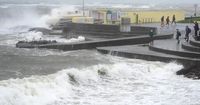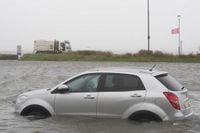Storm Amy, the first named storm of the 2025-2026 season, has battered the UK and Ireland with a ferocity that few anticipated, leaving a trail of destruction, widespread power outages, and tragic loss in its wake. The storm struck late on October 3 and continued through October 4, unleashing wind gusts that reached up to 96 mph on Scotland’s island of Tiree and setting a new record for the deepest area of low pressure in the UK for October. As communities across both countries scrambled to respond, the human and infrastructural toll mounted hour by hour.
In the Republic of Ireland, the consequences were immediate and severe. According to the Electricity Supply Board (ESB), more than 184,000 homes, farms, and businesses were plunged into darkness by 5:15 pm on October 3, with the hardest-hit counties including Galway, Mayo, Sligo, Roscommon, Leitrim, Cavan, and Donegal. The ESB cautioned that “crews will continue the restoration work for as long as possible this evening, but it is likely that the majority of customers will not have their power restored tonight due to the hazardous weather conditions and accessibility challenges.”
Tragically, the storm claimed at least one life. Irish police confirmed that a man in his 40s died in the Letterkenny area of County Donegal, an incident they are treating as weather-related. Earlier reports also noted that a man sustained serious injuries in Letterkenny shortly after 4:15 pm on October 3, again attributed to the storm’s extreme conditions. The Republic’s forecasting agency, Met Éireann, issued a rare red wind alert for Donegal, urging residents to shelter indoors between 4 pm and 6 pm. Keith Leonard, from the National Directorate for Fire and Emergency Management, told RTE’s News At One, “If I had one key message it would be for that period from 4 to 6 in Donegal this afternoon, to ask people to shelter in place for that amount of time and to be very careful on the roads before that warning comes into place and after it’s gone through.”
Across Northern Ireland, the picture was equally grim. NIE Networks reported around 50,000 customers without power as of Friday evening, with hundreds of fallen trees causing travel chaos. The Police Service of Northern Ireland, in a statement cited by the Derry Journal, said, “The storm has already caused significant damage and NIE Networks report around 50,000 customers are currently without power and there has been disruption to travel across the country with hundreds of fallen trees already reported. The rail network has been suspended due to multiple tree falls across the network. Significant work is beginning to restore power and clear roads. This recovery operation will continue into tomorrow.”
Amber and yellow weather warnings blanketed the island, with the Met Office forecasting damaging winds of 60-70 mph inland and up to 80 mph along exposed coasts. In County Donegal, gusts reached 80 mph at Malin Head, while Magilligan in County Londonderry set a provisional October wind gust record for Northern Ireland at 92 mph. The Met Office warned of “possible disruption to public transport, hazardous driving conditions, potential power cuts and dangerous waves,” and urged caution, particularly in exposed coastal and hilly areas.
Schools across large swathes of Northern Ireland closed early on October 3, with the Education Authority explaining that the decision was made “in the interest of the safety of children, young people and staff.” Flights and trains were disrupted, and multiple roads, including part of the M1, were closed due to fallen trees. Ferry crossings between Cairnryan in Dumfries and Galloway and Northern Ireland were cancelled, and several flights were grounded. The junior and mini Great Scottish Run in Glasgow was also called off due to safety concerns.
Scotland faced its own onslaught. The BBC reported that more than 60,000 homes were left without power overnight, with the Scottish and Southern Electricity Networks (SSEN) working to restore service to thousands of customers. Network Rail Scotland described the winds as hitting “much harder and more quickly” than anticipated, with over 60 incidents recorded in just the first two hours of the storm. About 80 trees were brought down on railway lines, forcing ScotRail to cancel all services from Glasgow Central until at least lunchtime on October 4. In Glasgow city centre, part of the Broomielaw was closed after a derelict building collapsed at around 6 pm on October 3. In Inverness, a large shop front sign was blown off at Inshes Retail Park, and in Aberdeenshire, a train was stranded after striking a fallen tree.
As the storm raged, the Met Office highlighted that Storm Amy had set a new record for the deepest low pressure area in the UK for October, with a central pressure of 947.9 hPa at Baltasound, Shetland—surpassing the previous record of 950.9 hPa set in 1988. This meteorological milestone underscored the storm’s exceptional intensity and the challenges faced by emergency services and utility crews.
In England and Wales, the effects were also widely felt. The Met Office issued a yellow weather warning covering virtually the entire country, predicting gusts of 40 to 55 mph and heavy rain, especially in western Scotland. All eight of London’s royal parks, including Hyde Park and Richmond Park, were closed on October 4 due to the severe wind gusts. The Royal Parks explained, “Due to severe wind gusts caused by Storm Amy, all of the royal parks, plus Brompton Cemetery and Victoria Tower Gardens will be closed on Saturday October 4.”
As the storm began to ease late on October 4, forecasters predicted that the worst of the weather would move towards Scandinavia by October 5. However, the cleanup and recovery efforts were just beginning. Police and local authorities continued to urge the public to avoid unnecessary travel, beware of fallen power lines, and report any hazards to the appropriate agencies. In Donegal, County Council crews prioritized clearing main routes, while in Northern Ireland, the rail network and many roads remained closed as teams worked to clear debris and restore power.
Storm Amy’s impact was felt not just in the numbers—homes without power, wind speed records broken, and transport routes disrupted—but in the human stories of resilience, tragedy, and community response. The storm’s ferocity serves as a stark reminder of nature’s power and the importance of preparedness as the UK and Ireland head further into the storm season.


